
The National Gallery of Victoria, popularly known as the NGV, is an art museum in Melbourne, Victoria, Australia. Founded in 1861, it is Australia's oldest and most visited art museum.

John Constable was an English landscape painter in the Romantic tradition. Born in Suffolk, he is known principally for revolutionising the genre of landscape painting with his pictures of Dedham Vale, the area surrounding his home – now known as "Constable Country" – which he invested with an intensity of affection. "I should paint my own places best", he wrote to his friend John Fisher in 1821, "painting is but another word for feeling".
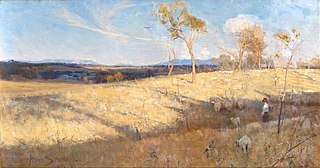
The Heidelberg School was an Australian art movement of the late 19th century. It has been described as Australian impressionism.

Arthur Merric Bloomfield Boyd was a leading Australian painter of the middle to late 20th century. Boyd's work ranges from impressionist renderings of Australian landscape to starkly expressionist figuration, and many canvases feature both. Several famous works set Biblical stories against the Australian landscape, such as The Expulsion (1947–48), now at the Art Gallery of New South Wales. Having a strong social conscience, Boyd's work deals with humanitarian issues and universal themes of love, loss and shame.

Sir Arthur Ernest Streeton was an Australian landscape painter and a leading member of the Heidelberg School, also known as Australian Impressionism.

Frank Jeffrey Edson Smart was an expatriate Australian painter known for his precisionist depictions of urban landscapes that are "full of private jokes and playful allusions".

Frederick Ronald Williams OBE was an Australian painter and printmaker. He was one of Australia’s most important artists, and one of the twentieth century's major landscapists. He had more than seventy solo exhibitions during his career in Australian galleries, as well as the exhibition Fred Williams - Landscapes of a Continent at the Museum of Modern Art in New York in 1977.
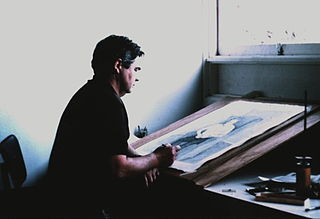
John Brack was an Australian painter, and a member of the Antipodeans group. According to one critic, Brack's early works captured the idiosyncrasies of their time "more powerfully and succinctly than any Australian artist before or since. Brack forged the iconography of a decade on canvas as sharply as Barry Humphries did on stage."
Janet Dawson MBE is an Australian artist who was a pioneer of abstract painting in Australia in the 1960s, having been introduced to abstraction during studies in England while she lived in Europe 1957–1960 She was also an accomplished lithographic printer of her own works as well as those of other renowned Australian artists, a theatre-set and furniture designer. She studied in England and Italy on scholarships before returning to Australia in 1960. She won the Art Gallery of New South Wales Archibald Prize in 1973 with the portrait of her husband, Michael Boddy Reading. She has exhibited across Australia and overseas, and her work is held in major Australian and English collections. In 1977 she was awarded an MBE for services to art.
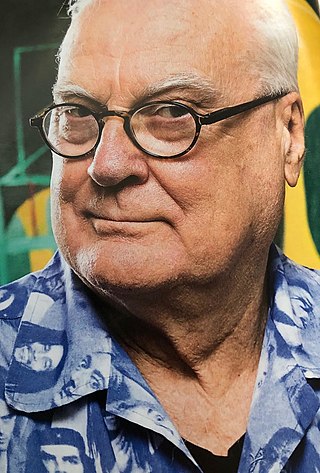
Gareth Sansom is an Australian artist, painter, printmaker and collagist and winner of the 2008 John McCaughey Memorial Prize of $100,000.

Collins St., 5 pm is a 1955 painting by Australian artist John Brack. The painting depicts office workers walking along busy Collins Street in Melbourne after finishing work for the day—"Blank-faced office workers hurry by like sleep-walkers, thinking only of the pubs or their homes in the suburbs". Brack conceived the work after reading T. S. Eliot's 1922 poem The Waste Land. It is considered a companion piece to Brack's earlier work The Bar.
Jane Wilson was an American painter associated with both landscape painting and expressionism. She lived and worked in New York City and Water Mill, New York.
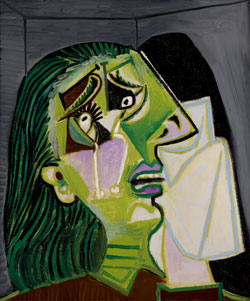
The theft of The Weeping Woman from the National Gallery of Victoria took place on 2 August 1986 in Melbourne, Victoria, Australia. The stolen work was one of a series of paintings by Pablo Picasso all known as The Weeping Woman and had been purchased by the gallery for A$1.6 million in 1985—at the time the highest price paid by an Australian art gallery for an artwork. A group calling itself "Australian Cultural Terrorists" claimed responsibility, making a number of demands in letters to the then-Victorian Minister for the Arts, Race Mathews. The demands included increases to funding for the arts; threats were made that the painting would be destroyed. After an anonymous tip-off to police, the painting was found undamaged in a locker at Spencer Street railway station on 19 August 1986. The theft still remains unsolved.
Peter Bray Gallery was established as Stanley Coe Gallery in 1949 before being renamed in 1951, after a change of management. Situated at 435 Bourke Street, Melbourne, Victoria, Australia, it closed in 1957. Many of the major names in mid-century Australian contemporary art showed there during its brief, but very busy, lifespan.
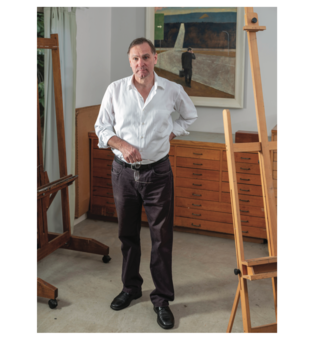
Peter Serwan is an Australian artist and educator based in Adelaide, South Australia. Serwan is known for his paintings of urban landscapes. Working mostly in the medium of oil paint, he is also a fine printmaker. Serwan draws his subjects from his immediate environment, frequently incorporating his family, friends, and colleagues as models. Recurring subjects in his works are backyards, suburban street fronts, and new housing developments. His paintings are often populated by suited men, stray dogs, cats, wheelie bins, and orange bunting. A testing ground for national identity, Serwan’s depictions of urban Australia reflect on themes of suburban isolation with an eye for the everyday minutiae of life, and its everyday absurdities and wonders, with dry wit and sharp observation. He has exhibited frequently in Australia and is represented in private and institutional collections.

The Block is a 1954 painting by Australian artist John Brack. The painting depicts the interior of an empty butcher's shop, including the eponymous butcher's block. It is one of a series of paintings—including The Barber's Shop (1952), The Fish Shop (1955) and Men's Wear (1955)—of small high street businesses.
The tools of the trade – choppers, knives and meathooks – hang from the rails. The butcher’s block, centrally placed and painted in a darker tone, dominates the composition. Despite the rather grisly subject matter, Brack has achieved a small, perfectly contained and beautifully painted jewel-like interior. The detail of the brushwork, with its meticulous lines and opaque passages of thin paint in the background, the fine scratches incised into the block to indicate its use, and the artist’s handmade wooden frame, all converge in an exquisite synthesis
Dorothy Mary Braund (1926–2013) was an Australian post-war figuration and contemporary feminist artist, whose practice included painting, printmaking and teaching. Braund's extensive career was instrumental in contributing to the Modernist art scene, along with a generation of significant women artists including: Mary Macqueen, Barbara Brash, Anne Marie Graham, Constance Stokes, Anne Montgomery (artist) and Nancy Grant. Braund's first solo exhibition, held in 1952 at Peter Bray Gallery in Melbourne, launched her career and from then on she had consistent shows and exhibitions. Braund has had approximately 29 solo exhibitions and participated in 25 group exhibitions throughout her career. Braund is also a part of the Cruthers Collection of Women's Art.
Barbara Mbitjana Moore is an Anmatyerre woman who grew up in Ti-Tree in the Northern Territory, moving later to Amata in South Australia's Anangu Pitjantjatjara Yankunytjatjara (APY) Lands. In April 2003, Moore began painting at Amata's Tjala Arts, and, since then, has received widespread recognition. Moore won a National Aboriginal & Torres Strait Islander Art Award in 2012 and has been a finalist in many other years. Moore has also been a finalist for the Wynne Prize.

Laughing Child is a 1958 Modernist portrait painting by Australian artist John Brack. The painting depicts his daughter Charlotte as a young girl, in a dress and with messy hair, laughing.

Latin American Grand Final is a 1969 painting by Australian artist John Brack. Part of a series of paintings on the theme of ballroom dancing painted by Brack in the late 1960s, the painting depicts two ballroom dancers – a man and a woman – in a dance competition.
















